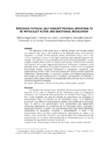Mostrar o rexistro simple do ítem
Perceived physical self-concept profiles: intention to be physically active and emotional regulation
| dc.contributor.author | Vega Díaz, Marta | |
| dc.contributor.author | Labra, Carmen de | |
| dc.contributor.author | González-García, Higinio | |
| dc.date.accessioned | 2023-05-26T06:10:20Z | |
| dc.date.available | 2023-05-26T06:10:20Z | |
| dc.date.issued | 2023 | |
| dc.identifier.citation | Vega-Díaz, M., De Labra, C., & González-García, H. (2023). Perceived physical self-concept profiles: intention to be physically active and emotional regulation. Behavioral Psychology/ Psicologia Conductual, 31(1), 179-196. | es_ES |
| dc.identifier.issn | 1132-9483 | |
| dc.identifier.uri | http://hdl.handle.net/2183/33147 | |
| dc.description.abstract | [Abstract] The objectives of the study were to identify physical self-concept profiles and examine their role in the intention to be physically active and emotional regulation. A sample of 606 physical activity practitioners (Mage= 34.19, SD= 13.05), completed a series of self-report measures that evaluated physical selfconcept, the intention to be physically active, and emotional regulation. Cluster analyzes revealed three profiles of physical self-concept. Profile b with relatively high physical self-concept experienced significant differences in intention to be physically active, self-blame, and positive reappraisal. Profile a with low physical self-concept showed significant differences in acceptance, rumination, and catastrophizing. Profile c with a very low physical self-concept revealed significant differences in blaming others. In conclusion, profile b with relatively high physical self-concept and with optimal scores in condition, attractiveness and strength is associated with a higher intention to be physically active and the use of functional emotional regulation strategies. | es_ES |
| dc.description.abstract | [Resumen] Los objetivos del estudio fueron identificar perfiles de autoconcepto físico y examinar su rol sobre la intención de ser físicamente activo y la regulación emocional. Una muestra de 606 practicantes de actividad física (Medad= 34,19; DT= 13,05) completó una serie de medidas de autoinforme que evaluaban el autoconcepto físico, la intención de ser físicamente activo y la regulación emocional. Los análisis de conglomerados revelaron tres perfiles de autoconcepto físico. El perfil b con autoconcepto físico relativamente alto experimentó diferencias significativas en la intención de ser físicamente activo, autoculpa y reevaluación positiva. El perfil a con autoconcepto físico bajo mostró diferencias significativas en aceptación, rumiación y catastrofización. El perfil c con autoconcepto físico muy bajo reveló diferencias significativas en culpar a los demás. Como conclusión, el perfil b con autoconcepto físico relativamente alto está asociado con la mayor intencionalidad de ser físicamente activo y el uso de estrategias de regulación emocional funcionales. | es_ES |
| dc.language.iso | eng | es_ES |
| dc.publisher | Fundación Veca | es_ES |
| dc.relation.uri | https://doi.org/10.51668/bp.8323111n | es_ES |
| dc.subject | Self-concept | es_ES |
| dc.subject | Intention to be active | es_ES |
| dc.subject | Cluster analysis | es_ES |
| dc.subject | Emotion | es_ES |
| dc.subject | Autoconcepto | es_ES |
| dc.subject | Intención de ser activo | es_ES |
| dc.subject | Clúster análisis | es_ES |
| dc.subject | Emoción | es_ES |
| dc.title | Perceived physical self-concept profiles: intention to be physically active and emotional regulation | es_ES |
| dc.type | info:eu-repo/semantics/article | es_ES |
| dc.rights.access | info:eu-repo/semantics/openAccess | es_ES |
| UDC.journalTitle | Psicología Conductual | es_ES |
| UDC.volume | 31 | es_ES |
| UDC.issue | 1 | es_ES |
| UDC.startPage | 179 | es_ES |
| UDC.endPage | 196 | es_ES |
Ficheiros no ítem
Este ítem aparece na(s) seguinte(s) colección(s)
-
GI-NEURO - Artigos [158]






